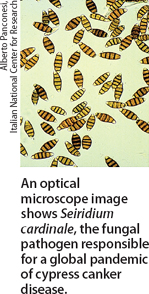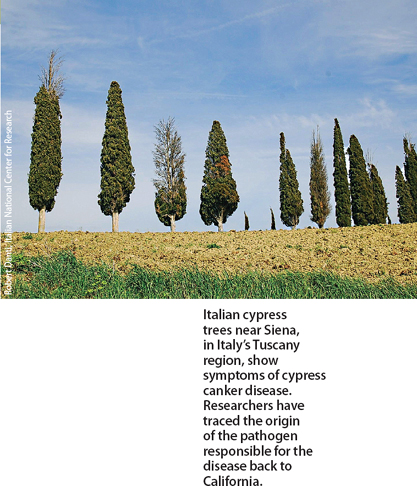All Issues
Tree-killing pathogen traced back to California
Publication Information
California Agriculture 65(4):183-183.
Published October 01, 2011
PDF | Citation | Permissions
Full text
Genetic detective work by an international group of researchers may have solved a decades-long mystery of the source of a devastating tree-killing fungus that has hit six of the world's seven continents.
In a Sept. 1 Phytopathology study, California emerged as the top suspect for the pathogen, Seiridium cardinale, that is the cause of cypress canker disease. S. cardinale was first identified as causing the disease in California's San Joaquin Valley in 1928. The fungus has made its way since to Europe, Asia, New Zealand, Australia, South America and Africa. In many regions, it has infected and killed up to 95% of iconic native trees in the cypress family, including junipers and some cedars.
The researchers used DNA fingerprinting techniques to analyze 96 S. cardinale isolates of diseased tree samples from seven Mediterranean countries, eight California counties, Chile and New Zealand. The paper reports that strains of the pathogen with identical DNA profiles were found hundreds to thousands of miles apart, an indication that humans are moving the pathogen, most likely through the trade of infected plants.
An optical microscope image shows Seiridium cardinale, the fungal pathogen responsible for a global pandemic of cypress canker disease.
“When Monterey cypress trees are planted in Monterey or along the coast, they are resistant to the disease,” said Matteo Garbelotto, UC Cooperative Extension specialist, Berkeley, and an author of the study. “That suggests that in coastal areas, the environment is unfavorable for development of infections, despite the pathogen having been in California for a long time. The pathogen emerges when we place the tree in a foreign environment.”
Italian cypress trees near Siena, in Italy's Tuscany region, show symptoms of cypress canker disease. Researchers have traced the origin of the pathogen responsible for the disease back to California.
Garbelotto said that chemical treatments for cypress canker disease may become available in the near future, but they are costly and their effects on the environment are not clear so prevention is preferable.
The fungus kills a tree by entering through cracks in its bark, producing toxins that wreak havoc with its flow of sap and choke off its supply of water and nutrients. The disease has left an indelible mark throughout southern Europe.
For more info, go to: http://newscenter.berkeley.edu/2011/09/01/cypress-canker-pathogen-traced-to-california .






